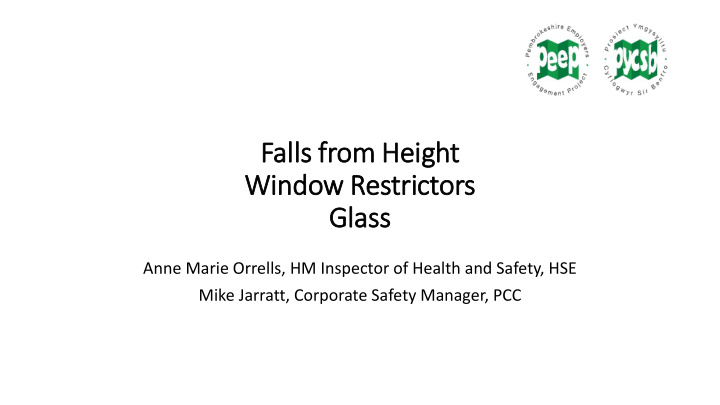



Fall lls fr from Heig ight Win indow Restrictors Gla lass Anne Marie Orrells, HM Inspector of Health and Safety, HSE Mike Jarratt, Corporate Safety Manager, PCC
Window Restrictors-Falls • Risk assessment: individual and the environment – vulnerable persons • Engineering controls – robust measures • Maintenance • Training and supervision • Fire risk assessment NB – Building regs do not require fully openable windows within such care settings – other means of escape required
Window Requirements Window restrictors – is it likely vulnerable individuals can fall or climb through a window & injure themselves? If so, accessible windows should be restrained sufficiently to prevent falls. They should: • Restrict opening to 100mm or less • Be suitably robust to withstand damage or forces that may be applied by a determined individual • Be robustly secured using tamper proof fittings and can only be overridden using special tools or key (i.e. not accessible tools such as cutlery or screwdriver etc.)
Other requirements Workplace (Health, Safety & Welfare) Regulations 1992 : • Bottom edge of opening windows should be at least 800mm above floor level, unless there is a barrier to prevent falls This is to reduce the risk of inadvertent falls where fully openable windows are assessed as being appropriate. It will also help reduce service user risk falls. A robust restricted window may be considered to be a barrier where glass is also strong enough or a physical barrier is present.
Managing the risk Falls from windows
Managing the risk Falls from windows Inadequate: Restrictors are easily over ridden
Case studies Evidence at the inquest demonstrated that: If the cable was clipped into the socket by a simple push it would appear secure when pulled or tugged. However, just by pushing the key lock/release button the cable was released. b. The cable was only secure when physically locked with a key c. Even if locked with the key, the lock was easily defeated within no more than a couple of seconds by inserting the blade of a pair of scissors into it.
Case studies • Deceased resident at the care home was found on the ground below an open window. (Fined £450,000) • It is understood that even though a window restrictor has been installed the patient somehow managed to get through the opening between the window and the frame and fall from the second floor. Patient later died. (Fined £200,000) • Did not adequately prevent access to stairs and resident of care home fell down stairs to her injury and subsequent death. (Fined £120,000)
Managing the risk Falls from windows
Snake eye, pig nose, or 2 hole Pin hex Pin torx, star drive pin Special tools Clutch head One way
Maintenance Maintenance of restrictors is ‘key’ • Adequacy of fittings • Signs of wear or damage • Robustness of restrictors – appropriate for determined adults
Building work, refurbishment etc. • Are builders, architects, etc. aware of requirements? • Check measurement – 100mm? • Should not be needed as a fire escape – see your Fire Risk Assessment! • Have existing restrictors been broken or overridden during building work?
Glazing – Workplace (Health, Safety & Welfare)1992 & Regulations 1992 & Building Regulations Glazing, with which people are likely to come into contact whilst moving in or about the building shall: a) If broken on impact, break in a way which is unlikely to cause injury; or b) Resist impact without breaking; or c) Be shielded or protected from impact. As a rule of thumb doors and glazing below waist height / 800mm. Also risk assess other areas – e.g. next to bath
Stairs • Maintain in a safe condition. • Keep free from obstructions and contamination. • Well lit. • Suitable hand rails (on both sides). • Not excessively steep and winding • No open risers.
Falls from bed Bed rails, also known as side rails or cot sides, can reduce the risk of falls when used with the right bed, in the right way, for the right person. Accident data shows that bed rails can introduce other risks: • Poorly fitting bed rails where a person’s neck, chest or limbs become trapped in gaps between the bed rails or between the bed rail and the bed, headboard, or mattress. • rolling over the top of the rail when overlay mattresses reduce their effective height • climbing over the rail • climbing over the footboard
Managing the risk with bedrails • they are only provided when they are the right solution to prevent falls • a risk assessment is carried out by a competent person taking into account the bed occupant, the bed, mattresses, bed rails and all associated equipment – current standard BS EN 60601-2-52:2010 • the rail is suitable for the bed and mattress • the mattress fits snugly between the rails • the rail is correctly fitted, secure, regularly inspected and maintained • gaps that could cause entrapment of neck, head and chest are eliminated • staff are trained in the risks and safe use of bed rails
Further guidance HSE H&SC Falls from windows / balconies webpage: http://www.hse.gov.uk/healthservices/falls- windows.htm HSE Information Sheet – Falls from windows or balconies in health and social care - HSIS5: http://www.hse.gov.uk/pubns/hsis5.htm DoH Safety Alert - https://www.cas.dh.gov.uk/ViewandAcknowledgment/ViewAlert.aspx?AlertID=102246 DH HBN 00-10 Part D - https://www.gov.uk/government/uploads/system/uploads/attachment_data/file/273867/201312 23_HBN_00-10_PartD_FINAL_published_version.pdf HSE Sector Information Minute (SIM 07/2012/06) - Bed rail risk management http://www.hse.gov.uk/foi/internalops/sims/pub_serv/07-12-06/ (including BS EN 60601-2- 52:2010 http://www.hse.gov.uk/foi/internalops/sims/pub_serv/07-12-06/appendix-3.pdf) HSE publication ‘ Health and safety in care homes – HSG220’ http://www.hse.gov.uk/pubns/books/hsg220.htm
Recommend
More recommend